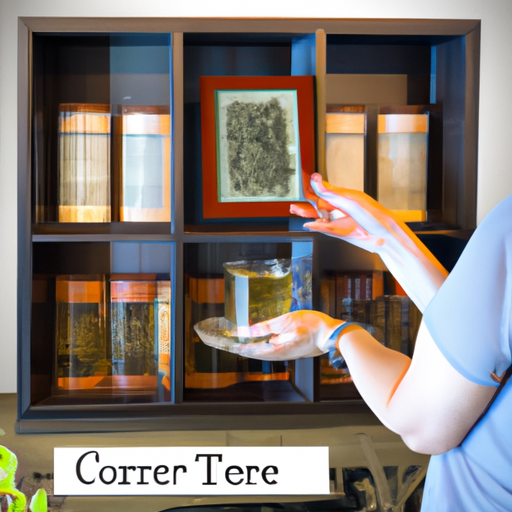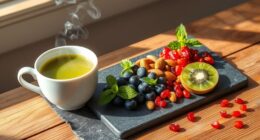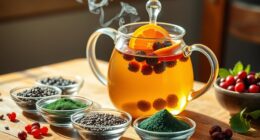Imagine stepping into your backyard and inhaling the scents of fresh herbs in the air, hearing birds chirping, and feeling the sun’s warmth on your skin. Envision yourself enjoying a hot cup of tea brewed from herbs you cultivated yourself.
That dream can become a reality with a herbal tea garden. In this article, I will guide you through the process of creating your own little oasis of herbal goodness.
We will start by selecting the perfect herbs for your tea garden, ensuring a delightful blend of flavors and aromas. Then, we will find the ideal spot in your yard to set up your garden, taking into consideration sunlight, soil quality, and accessibility.
Once we have our location, we’ll prepare the soil and get our hands dirty, planting and caring for our tea herbs. After months of nurturing, we will finally harvest and dry our herbs, preserving their vibrant flavors.
And finally, I’ll share tips on storing and enjoying your homegrown herbal teas. So, let’s get started on this journey to create your very own herbal tea paradise!
Key Takeaways
- Select herbs that complement each other and create a variety of flavors for your teas.
- Choose herbs that provide the desired herbal tea benefits, such as calming or refreshing effects.
- Research the growing requirements of each herb and ensure they can thrive in your climate.
- Find a suitable spot in your yard with at least 6 hours of direct sunlight or consider shade-tolerant herbs for limited sunlight areas.
Choose the Right Herbs for Your Tea Garden
When planning your herbal tea garden, it’s important to choose the right herbs that will complement each other and create a variety of flavors for your teas. Start by considering the herbal tea benefits you want to experience.
For example, if you’re looking for a calming tea, chamomile and lavender are excellent choices. If you’re seeking a refreshing and energizing tea, peppermint and lemon verbena are perfect options.
Additionally, think about the herbal tea recipes you enjoy the most. For a citrusy blend, try adding lemongrass and lemon balm. If you prefer a floral taste, consider growing rose petals and hibiscus.
Remember to research each herb’s growing requirements and ensure they can thrive in your climate. Now that you have an idea of the herbs you want, let’s find the perfect spot for your garden.
Find the Perfect Spot for Your Garden
Choosing the right location for your herbal tea garden is like finding the perfect stage for a ballet performance, where each plant can dance gracefully to the rhythm of sunlight and soil. To ensure your herbs thrive and produce flavorful leaves, consider the following factors:
-
Sunlight requirements: Most herbs prefer full sun, so choose a spot with at least 6 hours of direct sunlight. If you have limited sunlight, opt for shade-tolerant herbs like mint or lemon balm.
-
Watering needs: Herbs generally prefer well-draining soil, so avoid areas prone to waterlogging. Regular watering is crucial, especially during hot and dry periods.
Finding the ideal spot for your herbal tea garden is essential to create an environment where your plants can flourish. Once you’ve chosen the perfect location, it’s time to prepare the soil for planting.
Prepare the Soil for Planting
Now that you’ve found the ideal spot, it’s time to get your hands dirty and prepare the soil for planting.
Soil preparation is a crucial step in growing a successful herbal tea garden. Start by removing any weeds or grass from the area. Loosen the soil with a garden fork or tiller, ensuring it’s well-drained and crumbly.
If you’re unsure about the soil’s pH level and nutrient content, consider conducting a soil test. This’ll help you determine if any amendments, such as lime or organic matter, need to be added.
Once the soil is prepared, you can transition into the subsequent section about planting and caring for your tea herbs. Remember, healthy soil is the foundation for a thriving garden.
Plant and Care for Your Tea Herbs
To ensure the longevity of your tea herbs, it’s important to know that certain varieties, like chamomile and lavender, can live for up to 20 years with proper care. Tea herb maintenance is essential for the health and productivity of your plants.
Regular watering is crucial, especially during dry spells, as herbs like a moist but well-drained soil. Mulching around the plants can help retain moisture and suppress weeds. It’s also important to monitor for pests and diseases, as they can quickly damage your herbs. Regularly inspect your plants and take appropriate action if you notice any issues.
Growing your own herbs has numerous benefits, such as having access to fresh, flavorful tea at any time, and the satisfaction of knowing exactly where your herbs come from.
Now, let’s explore how to harvest and dry your herbs for the perfect cup of tea.
Harvest and Dry Your Herbs
One essential step in getting the perfect cup of tea is harvesting and drying your herbs. Preserving the freshness of your herbs is crucial to maintain their flavor and aroma. There are different drying methods you can use, depending on the herb and your preference. The table below provides a comparison of three common drying methods: air drying, oven drying, and using a food dehydrator.
| Drying Method | Pros | Cons |
|---|---|---|
| Air Drying | Easy and cost-effective | Takes longer to dry |
| Oven Drying | Quick and efficient | Requires constant monitoring |
| Food Dehydrator | Fast and consistent | Requires special equipment |
Choose the method that suits your needs best. Once your herbs are dry, store and preserve them properly to ensure their longevity and potency. This will be discussed further in the next section about how to store and preserve your herbal teas.
Store and Preserve Your Herbal Teas
Ensure that you store and preserve your herbal teas properly to maintain their freshness and potency, allowing you to enjoy a flavorful and aromatic cup of tea whenever you desire. When it comes to brewing herbal teas, there are various methods you can try. You can steep the herbs in hot water for a few minutes or use a tea infuser to extract their flavors. Experiment with different combinations of herbs to create your own unique blends.
Additionally, herbal teas can be used creatively in recipes. You can infuse them into syrups, dressings, or even desserts to add a subtle herbal twist. By exploring these different brewing methods and incorporating herbal teas into your recipes, you can fully experience the versatility of your homegrown herbs.
Transitioning into the next section, let’s now explore how to enjoy your homegrown herbal teas without any additional steps.
Enjoy Your Homegrown Herbal Teas
Savor the delightful flavors and aromas of your very own handcrafted herbal infusions. There’s nothing quite like the satisfaction of enjoying a cup of tea made from herbs you grew yourself. Making herbal tea blends is a great way to experiment with different flavors and create personalized concoctions. You can mix and match herbs to suit your taste preferences and even add in other ingredients like dried fruits or spices for an extra twist. Not only do homegrown herbal teas taste amazing, but they also offer a range of health benefits. Herbal teas are known for their calming and soothing properties, and they can help with digestion, boost immunity, and promote relaxation. So sit back, relax, and sip on the goodness of your own garden-grown herbal teas.
| Benefits of Drinking Herbal Tea | Making Herbal Tea Blends |
|---|---|
| Calming and soothing properties | Experiment with flavors |
| Aid digestion | Mix and match herbs |
| Boost immunity | Add dried fruits or spices |
| Promote relaxation | Personalize your blends |
Frequently Asked Questions
Can I use any type of soil for my tea garden?
Choosing the right soil for your tea garden is crucial for its success. Prepare the soil by ensuring it is well-draining, rich in organic matter, and slightly acidic. This will provide the ideal conditions for your herbs to thrive and produce flavorful tea.
How often should I water my tea herbs?
To prevent overwatering in my tea garden, I observe the soil’s moisture level by sticking my finger an inch deep. If it feels dry, I water the herbs thoroughly. This way, I choose the best watering schedule for my tea herbs.
Are there any herbs that should not be planted together in a tea garden?
Certain herbs can have negative interactions when brewed together, affecting the flavor of the tea. It’s important to consider the effects of different herb combinations on tea flavor before planting them together in a tea garden.
Can I use chemical fertilizers in my tea garden?
I wouldn’t touch chemical fertilizers with a ten-foot pole in my tea garden! Organic fertilizers like compost and manure have pros like promoting soil health and cons like slower release of nutrients. Best practices are to test soil and amend accordingly.
How long can I store my dried herbal teas before they expire?
You can store dried herbal teas for up to two years if stored properly. To preserve them, use airtight containers and keep them in a cool, dark place, away from moisture and sunlight.
Conclusion
In conclusion, growing an herbal tea garden is a rewarding and fulfilling experience. By choosing the right herbs, finding the perfect spot, preparing the soil, and caring for your plants, you can create a thriving garden.
Harvesting and drying your herbs allows you to enjoy their flavors and benefits for months to come. By storing and preserving your herbal teas properly, you can savor the taste of your homegrown teas all year round.
So start your herbal tea garden today and indulge in the goodness of nature’s healing brews.










